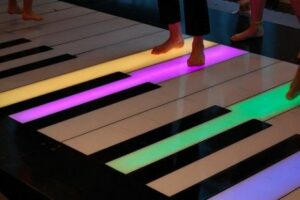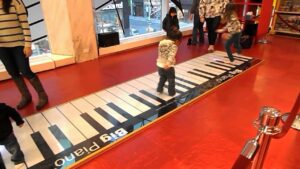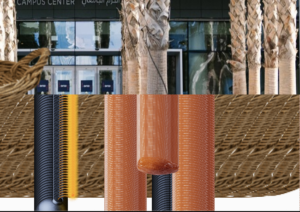VR Archery
My game was all about creating a virtual archery game and linking a flex sensor to the bow, so it detects the bending motion and once bent the arrow shoots onto the target. For the theme of the entire game, I decided to link it with my childhood as well and use Minecraft as the main theme. As a 9 year old, I used to go to the archery range and play Minecraft at the time so it brought up a sense of nostalgic feeling.
For the bow, in order to give it a pixelated look, I decided to super glue the tiny wooden square blocks and paint over it. I attached the flex sensor on the top of the bow and attached a string to the flex sensor so when the string is pulled it shoots the arrow.
Future Improvements:
For future improvements, I’d like to add more visuals. I felt like it would’ve been more engaging if I did.
Pictures and Documentation:
Soldering documentation :
https://youtube.com/shorts/Cn9bonfPVeI?feature=share
Game play:
https://youtube.com/shorts/6olYsuVx5k8?feature=share
The Game & Codes:
<iframe src=”https://editor.p5js.org/sa6607/full/wcM5zq8Fr”></iframe>
P5 Code:
const serial = new p5.WebSerial();
let startButton;
let portButton;
let closeButton;
let sensorValue = 0;
let width = 900;
let height = 506;
let arrowSpeed = 5; // Speed at which arrow moves
let arrowDirection = 1;
let score = 0;
let shooting = false; // Indicates whether the arrow is currently being shot
let arrowX = width / 2; // X-coordinate of the arrow
let arrowY = height; // Y-coordinate of the arrow
let arrowScaleX = 1;
let arrowScaleY = 1;
let arrowWidth = 60;
let arrowHeight = 120;
let targetX = width / 2;
let targetY = height / 2;
let targetRadius = 100;
let started = false;
let bgImg;
let arrowImg;
let targetImg;
let sliderX = width - 50;
let sliderY = height / 2;
let lastScore = 0;
let textOpacity = 0;
let sliderHeight = 0;
let startShootFlag = 0;
let sliderIncrementor = 1;
let sliderTotalHeight = 100;
let startShootThreshHold = 40; //set flex sensor value at which we start for targetting
function allSerialStuff() {
if (!navigator.serial) {
alert("WebSerial is not supported in this browser. Try Chrome or MS Edge.");
}
// check for any ports that are available:
serial.getPorts();
// if there's no port chosen, choose one:
serial.on("noport", makePortButton);
// open whatever port is available:
serial.on("portavailable", openPort);
// handle serial errors:
serial.on("requesterror", portError);
// handle any incoming serial data:
serial.on("data", serialEvent);
serial.on("close", makePortButton);
// add serial connect/disconnect listeners:
navigator.serial.addEventListener("connect", portConnect);
navigator.serial.addEventListener("disconnect", portDisconnect);
}
function serialEvent() {
sensorValue = Number(serial.read());
console.log(sensorValue);
//if certain value from flex sensor get passed we get prepared for the shoot
if (!shooting && sensorValue > startShootThreshHold) {
startShootFlag = 1;
sliderHeight = sensorValue + 20; // add 20 to elevate the value we need something in between 0-120
}
//if that value again crossed then we shoot
if (!shooting && sensorValue < startShootThreshHold && startShootFlag) {
startShootFlag = 0;
if (!shooting && arrowY == height) {
shooting = true; // Start shooting
}
}
}
// if there's no port selected,
// make a port select button appear:
function makePortButton() {
// create and position a port chooser button:
portButton = createButton("Choose Port");
portButton.position(innerWidth / 2, 10);
portButton.center("horizontal");
// give the port button a mousepressed handler:
portButton.mousePressed(choosePort);
}
// make the port selector window appear:
function choosePort() {
if (portButton) portButton.show();
serial.requestPort();
}
// open the selected port, and make the port
// button invisible:
// open the selected port, and make the port
// button invisible:
function openPort() {
// wait for the serial.open promise to return,
// then call the initiateSerial function
serial.open().then(initiateSerial);
// once the port opens, let the user know:
function initiateSerial() {
console.log("port open");
}
// hide the port button once a port is chosen:
if (portButton) portButton.hide();
makeCloseButton();
if (closeButton) closeButton.show();
}
// pop up an alert if there's a port error:
function portError(err) {
alert("Serial port error: " + err);
}
// read any incoming data as a string
// (assumes a newline at the end of it):
// try to connect if a new serial port
// gets added (i.e. plugged in via USB):
function portConnect() {
console.log("port connected");
serial.getPorts();
}
// if a port is disconnected:
function portDisconnect() {
serial.close();
console.log("port disconnected");
}
// if there's no port selected,
// make a port select button appear:
function makeCloseButton() {
// create and position a port chooser button:
closeButton = createButton("Close Port");
closeButton.position(innerWidth / 2, 10);
closeButton.center("horizontal");
// give the close port button a mousepressed handler:
closeButton.mousePressed(closePort);
}
function closePort() {
serial.close();
if (closeButton) closeButton.hide();
}
function preload() {
bgImg = loadImage("/assets/background.jpg");
targetImg = loadImage("/assets/target.png");
arrowImg = loadImage("/assets/arrow.png");
}
function setup() {
createCanvas(width, height);
startButton = createButton("Start Game");
startButton.addClass("start-button");
startButton.position(innerWidth / 2, innerHeight / 2 + 10);
startButton.center("horizontal");
startButton.mousePressed(startGame);
allSerialStuff();
}
function draw() {
imageMode(CORNERS);
image(bgImg, 0, 0, width, height);
if (!started) {
drawMenu();
} else {
// Draw target
drawTarget();
if (startShootFlag) {
drawSlider();
}
//Draw score
textAlign(LEFT, TOP);
textSize(26);
fill("red");
text("Score: " + score, 10, 10);
makeShooting();
drawArrow();
drawAddedScore();
}
}
function drawMenu() {
textSize(48);
fill("#ff0033");
textStyle(BOLD);
textAlign(CENTER, BASELINE);
text("VR Archery", width / 2, height / 2 - 100);
}
function startGame() {
if (startButton) startButton.hide();
started = true;
}
function makeShooting() {
if (shooting) {
// Calculate the trajectory towards the target
let deltaY = height - targetY; // Difference in y-coordinates between arrow and target
arrowY -= deltaY / 50; // Move the arrow towards the target
if (arrowScaleY > 0.4) {
arrowScaleY -= 0.004;
}
if (arrowScaleX > 0.4) {
arrowScaleY -= 0.005;
}
// Stop shooting when arrow reaches the target
if (arrowY - (arrowHeight * arrowScaleY) / 2 <= targetY) {
shooting = false;
// Check if the arrow hits the target
let distance = dist(arrowX, arrowY - (arrowHeight * arrowScaleY) / 2, targetX, targetY); // Calculate distance between arrow tip and target center
if (distance <= targetRadius - 20) {
console.log("Hit!");
arrowSpeed = 0;
textOpacity = 255;
updateScore(distance);
//reset arrow after 2 seconds
setTimeout(() => {
arrowY = height;
arrowScaleX = 1;
arrowScaleY = 1;
arrowSpeed = 5;
textOpacity = 0;
}, 2000);
} else {
console.log("Miss!");
arrowY = height;
arrowScaleX = 1;
arrowScaleY = 1;
shooting = false;
}
}
} else {
// Move arrow
arrowX += arrowSpeed * arrowDirection;
if (arrowX >= width || arrowX <= 0) {
arrowDirection = -arrowDirection; // Reset arrow when it goes beyond the canvas
}
}
}
function drawTarget() {
imageMode(CENTER);
image(targetImg, targetX, targetY, targetRadius * 2, targetRadius * 2);
}
function drawArrow() {
imageMode(CENTER);
image(arrowImg, arrowX, arrowY, arrowWidth * arrowScaleX, arrowHeight * arrowScaleY);
}
function drawAddedScore() {
fill(80, textOpacity);
text("+ " + lastScore, targetX + 70, targetY - 60);
}
function drawSlider() {
line(sliderX, sliderY, sliderX, sliderY + 120);
line(sliderX - 10, sliderY, sliderX + 10, sliderY);
line(sliderX - 10, sliderY + 60, sliderX + 10, sliderY + 60);
line(sliderX - 10, sliderY + 120, sliderX + 10, sliderY + 120);
fill(sliderHeight + 100, 200, 0);
rect(sliderX - 10, sliderY, 20, sliderHeight);
}
//update score
function updateScore(distance) {
console.log(distance);
if (distance < 10) {
score += 100;
lastScore = 100;
} else if (distance < 25) {
score += 80;
lastScore = 80;
} else if (distance < 40) {
score += 60;
lastScore = 60;
} else if (distance < 55) {
score += 40;
lastScore = 40;
} else {
score += 20;
lastScore = 20;
}
}
//handle mouse click event
function mouseClicked() {
if (!shooting && arrowY == height) {
//If arrow is not currently being shot
shooting = true; // Start shooting
}
}
function windowResized() {
if (startButton) startButton.position(innerWidth / 2, innerHeight / 2 + 10).center("horizontal");
if (portButton) portButton.center("horizontal");
if (closeButton) closeButton.center("horizontal");
}
Arduino Code:
void setup() {
Serial.begin(9600);
}
void loop() {
int analogValue = analogRead(A0);
byte byteToSend = map (analogValue, 0, 1023, 0, 255);
Serial.write(byteToSend);
delay(50);
}



